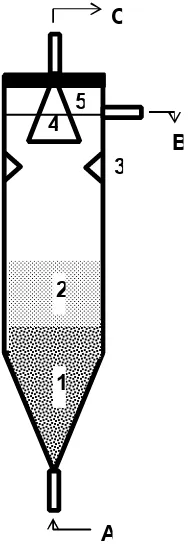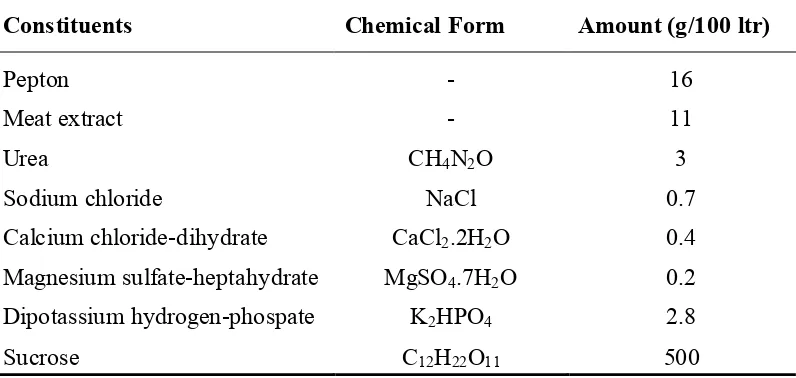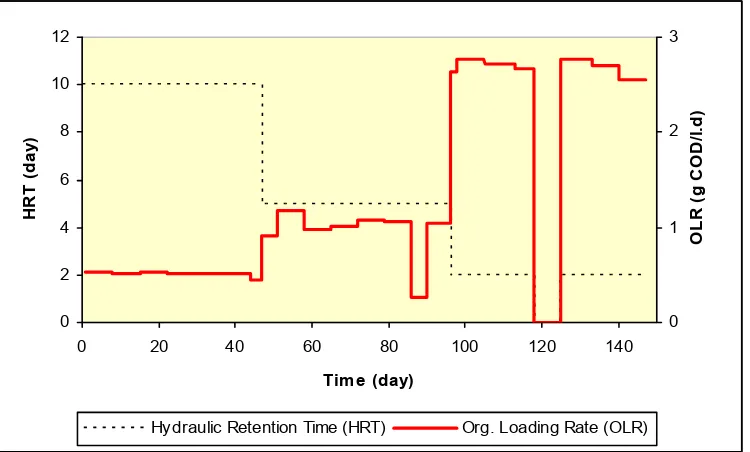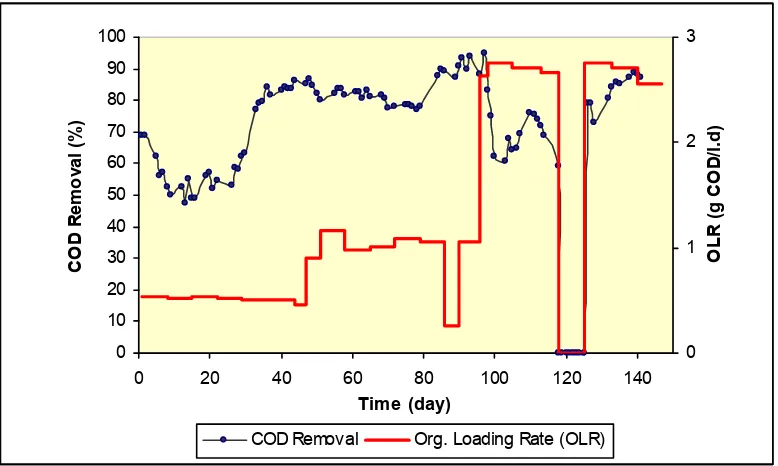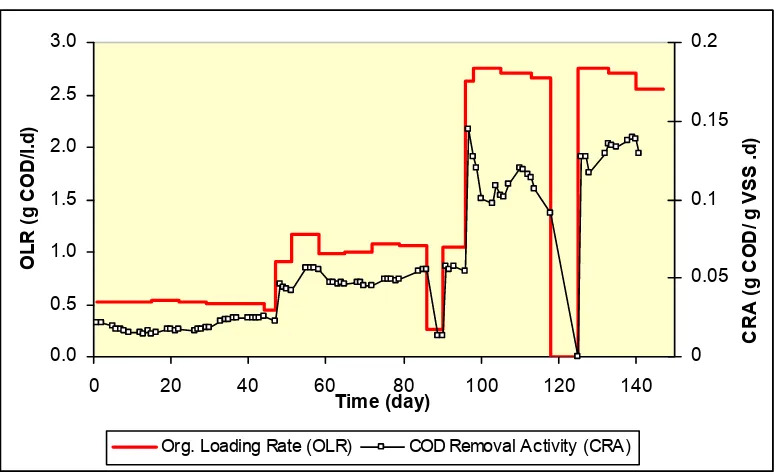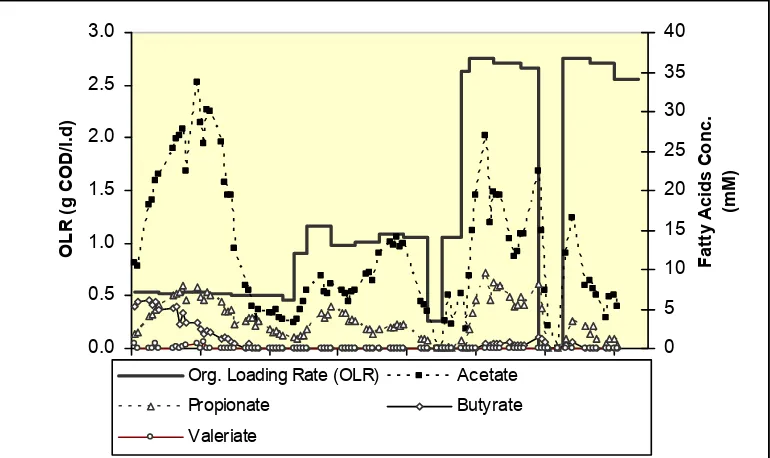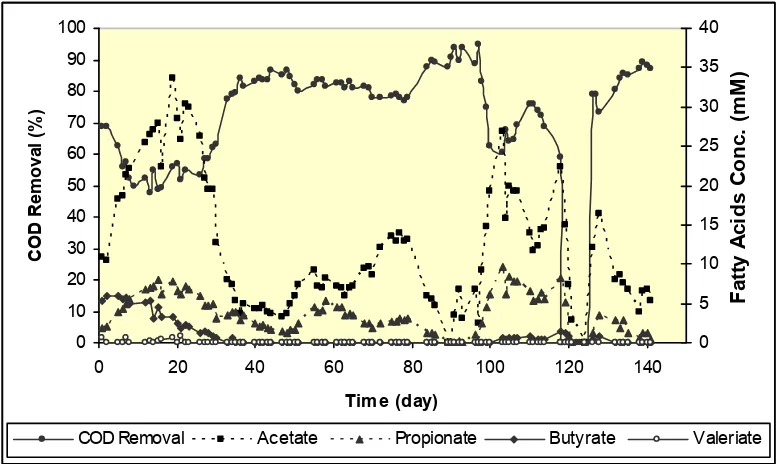ANAEROBIC TREATMENT OF WASTEWATER FROM SUGAR CANE
Sebuah reaktor upflow anaerobic sludge blanket(UASB) digunakan untuk mengetahui kemampuan proses anaerobik untuk menguraikan zat pencemar organik dari air limbah indusri gula. Dengan menggunakan lumpur granular dari reaktor UASB yang mengolah limbah industri buah dan sayur, reaktor dalam penelitian ini mampu mengurangi kandungan COD air limbah sampai 80 % dalam waktu 5 minggu sejak pertama kali dioperasikan. Selama waktu penelitian, reaktor dapat dioperasikan pada beban organik sebesar 2.7 g COD / l· d dengan efisiensi pengurangan COD rerata sebesar 86 %.
Kata kunci: UASB, proses anaerobik, limbah industri gula
INTRODUCTION
In many developing countries, especially in Asia and South America, sugar cane industry is one of the most important agricultural industries. As a consequence, sugar cane industry has significant wastewater production. Unfortunately, due to the lack of know-how and financial support, most of sugar cane industries in developing countries discharge their wastewater without adequate treatment. Similar with other wastewater generated by food processing plants, wastewater from sugar cane industry generally contains organic materials such as carbohydrates and proteins.
Although anaerobic reactors for wastewater treatment have been used since more than 2000 years ago in the form of Indian and Chinese animal manure digesters (Veenstra, 2000), the anaerobic process had been ignored for a long time as an option for wastewater treatment since it was considered to be inefficient and too slow to serve the needs of quickly expanding wastewater volumes especially in industrialized and dense populated area (Polprasert et al., 2001). Pushed by the world energy crisis, anaerobic digestion for wastewater treatment has been “rediscovered” in the late of 1960s. Since the work of Young and McCarty (1969, cited in Hickey et al., 1991), the application of anaerobic process for industrial and municipal wastewater treatment has been considered as a practical and an economical alternative to aerobic wastewater treatment.
Considering the kinetics, microbiology and modelling aspects, Iza et al. (1991) suggested that the concept of high-rate anaerobic reactors is based on three fundamental aspects:
(i). Accumulation of biomass within the reactor. Since the growth of microorganisms is very slow, the efficient operation of high rate anaerobic treatment is determined by the ability of to retain biomass concentration within the reactor by effective separation of the biomass from the liquid. This aspect can be reached by means of settling, attachment to support media or by recirculation.
(ii). Improving contact between wastewater and biomass. This aspect overcomes the problems of substrates and products from the bulk liquid to the biomass (biofilms or granules). It can be reached by proper mixing within the reactor (e.g.: contact process reactor), evenly distributing the effluent and avoiding short-circuit (e.g.: anaerobic filter reactor, UASB, and fixed bed reactor) or providing sufficient reactor height in order to achieve proper distribution of effluent (e.g.: downflow stationary fixed film reactor).
necessary to characterize the population dynamics and activity of these different groups.
The purpose of this study is to examine the biodegradability of organic components of wastewater from sugar cane industry wastewater and to examine the possibility of using upflow anaerobic sludge blanket reactor to treat wastewater from sugar cane industry by evaluating the start-up process and the operation performance.
MATERIALS AND METHODS
An upflow anaerobic sludge blanket (UASB) reactor with an operational volume of 2.3 L (including recirculation flow) was employed in this study. The reactor was water jacketed and operated at constant temperature of 37 oC.
Schematic diagram of the reactor used in this study is shown in Figure 1.
Figure 1. Typical cross section of a UASB reactor:
11 2
3 4
A
B C
(1). granular sludge bed A: influent (2). sludge blanket zone B: effluent (3). gas bubbles deflector C: gas outlet (4). gas collector
(5). settling compartment
The inoculum for this reactor was granular sludge obtained from full scale UASB reactor treating wastewater from fruit and vegetables industry and was stored in 8 oC cooling room for 20 months. The initial weight of the seeding
sludge was approximately 43 g VSS (volatile suspended solids).
This study used artificial sugar cane industry wastewater, which was slightly modified from OECD synthetic wastewater for domestic wastewater (European Commision, 1967). This composition gave an average chemical oxygen demand (COD) value of 5700 mg/l.
Table 1.Composition of the synthetic sugar cane industry wastewater
Constituents Chemical Form Amount (g/100 ltr)
Pepton - 16
Meat extract - 11
Urea CH4N2O 3
Sodium chloride NaCl 0.7
Calcium chloride-dihydrate CaCl2.2H2O 0.4
Magnesium sulfate-heptahydrate MgSO4.7H2O 0.2
Dipotassium hydrogen-phospate K2HPO4 2.8
Sucrose C12H22O11 500
In the start-up period, the reactor was continuously fed with wastewater was started with a hydraulic retention time (HRT) of 10 days. After stable performance was achieved, the organic loading rate (OLR) was increased by lowering the HRT to 5 days, 2 days and 1 day.
The residual volatile fatty acid composition of the effluent was determined using a method that was described by Gallert and Winter (1997). The measurement was done with a gas chromatograph from PACKARD, model 437 A. The gas chromatograph equipped with a flame ionisation detector (FID) with hydrogen (30 ml/min.) and syntethic air (300 ml/min.) as burning gas.
RESULTS AND DISCUSSION Loading Regimes
As soon as the inoculum sludge was transferred, the reactor was filled with tap water and then continuously fed with sugar cane wastewater at hydraulic retention time (HRT) of approximately 10 days. This HRT gave the reactor an organic loading rate (OLR) of approximately 0.5 g COD/ l· d. After COD removal efficiency of the reactor reached over 80%, the OLR was increased step wisely by lowering the HRT. During the operation of the reactor in this experiment, the
Hydraulic Retention Time (HRT) Org. Loading Rate (OLR)
In the 18th week of operation, reactor R2 experienced a failure of removed, the reactor was reloaded with an OLR of 2.7 g COD / l· d.
COD Removal Efficiencies and COD Removal Activities
After initial loading with an OLR of 0.5 g COD / l· d, the reactor had a COD removal efficiency of approximately 60 %. However, it took about 5 weeks to reach 80 % of COD removal efficiency. The COD removal efficiency of the reactor reached an average value of 84 % when the reactor was loaded with an OLR of 0.5 g COD / l· d (only in the stable operation phase). After increasing the OLR of the reactor to 1.1 g COD / l· d and 2.7 g COD / l· d, the average COD removal efficiency was 85 % and 86 %, respectively (see Fig. 3).
0
COD Removal Org. Loading Rate (OLR)
Figure 3 COD removal efficiency and its relationship to the OLR.
efficiency decreased from 88 % to 64 %. However, this OLR increment did not lead to an organic overload symptom. The COD removal efficiency was also hindered when the temperature was suddenly dropped. In the 18th week, the
reactor experienced a failure of the thermostat caused by a twisted tube. The failure caused the temperature of the reactor system drop from about 32 oC to
ambient temperature of approximately 20oC to 24 oC. This temperature decrease
occurred when the operation of the reactor was considered as not yet stable after increment of its organic loading rate (COD removal efficiency has not yet reached 80 % and residual fatty acids concentration in the effluent were more than 10 mM). The combination of both conditions caused the COD removal efficiency of the reactor dropped from 73 % to 59 %.
0.0
Org. Loading Rate (OLR) COD Removal Activity (CRA)
Figure 4 COD removal activity of reactor R1 and its relationship with the OLR.
Residual Volatile Fatty Acids
The predominant residual volatile fatty acids found in the reactor were acetate and propionate (see Fig. 5). Under stable operation, the concentration of acetate was much higher than the concentration of propionate. It can be concluded that acetate degradation was more rate-limiting compared to the other fatty acids degradation.
Org. Loading Rate (OLR) Acetate
Propionate Butyrate
Valeriate
0
COD Removal Acetate Propionate Butyrate Valeriate
Figure 6 Residual fatty acids in the effluent and the relationship with the COD removal efficiency
When the reactor reached stable operation, valeriate and butyrate concentrations in the effluent were zero or nearly zero. It could be concluded that valeriate and butyrate were easily degraded to acetate or propionate by acetogenic bacteria in the reactors, presumably Syntrophomonas wolfei.
If it is compared to the total COD value of the effluent, the COD value in the form of volatile fatty acids in the effluent had relatively high percentage. The COD value in the form of fatty acids reached a range of 50% to nearly 100% compared to the total COD value of the effluent. This high value indicates that sugar cane industry wastewater was relatively easy to degrade.
CONCLUSIONS AND RECOMMENDATIONS Conclusions
(Lettinga et al., 1980 in Polprasert et al. 2001). Granular sludge has the ability to increase its activity by applying a proper organic loading rate, considering the “readiness” of methanogenic bacteria to utilize the products of fermentive and/or acetogenic bacteria.
Lower temperature hindered the ability of UASB reactor to degrade organic materials. Failure of the thermostat caused the temperature of the reactor system to drop from about 32 oC to ambient temperature of about 20 oC to 24oC. In combination with a not yet stable operation after increment of its organic loading rate (COD removal efficiency have not yet reached 80 % and residual fatty acids in the effluent were more than 10 mM), the COD removal efficiency of the reactor dropped from 73 % to 59 %. The accumulation of fatty acids was also observed, indicating that there were unbalanced activities of acetogenic bacteria and methanogenic bacteria.
In general, it can be concluded that anaerobic processes can be used as an option for sugar cane industry wastewater treatment. Anaerobic technology offers high organic matter removal and possibility of energy recovery in the form of biogas.
Recommendations
Some recommendations are proposed based on the experiences of this study:
1. Fang and Chui (1993 cited in Fang et al., 1995) reported that the COD removal efficiency of an UASB reactor is mainly dependent on organic loading rate and was not sensitive to either COD level of wastewater or hydraulic retention time, thus the effort towards maximum operation of UASB reactor is suggested to be done by stepped-loading process. This method can be proceeded by considering the amount of organic loading rate and also hydraulic retention time, e.g. increasing the OLR from 1 kg COD /m3· d to 2 kg COD /m3· d to 3 kg COD /m3· d and so on (by means of
stepped-loading process is necessary to enhance the growth and activity of methanogenic bacteria and continue reactor efficiency.
2. Adjusting effluent recycle ratio is also necessary in order to enhance the mixing of wastewater and granular sludge bed and to avoid washout. In UASB reactors with a low flowrate and low organic concentration, natural mixing is not reliable since the force from effluent is very limited and only a few gas bubbles are produced. Thus, an effluent recycle is necessary.
3. To have higher COD removal efficiency, especially for carbohydrate-rich wastewater, that must be hydrolysed, it is suggested to have two stages of UASB process. The first reactor is used for hydrolysis and acidification process, and then the products of the first reactor (fatty acids) are fed as substrates to the second reactor. The second reactor functions as methanogenesis reactor.
REFERENCES
American Public Health Association (APHA), 1989. Standard Methods for the Examination of Water and Wastewater. Washington, D.C.: APHA Publisher
European Commision, 1967. Council Directive 67/548/EEC: Appendix V Methods for the Determination of the Physicochemical Characteristics, the Toxicity and the Ecotoxicity. Also available at: http://www.umweltrecht.de/ (last update: 2004).
Fang HHP, Li YY, and Chui HK, 1995. UASB Treatment of Wastewater with Concentrated Mixed VFA. Journal of Environmental Engineering, Vol. 121 (2): 153-160.
Hickey RF, Wu WM, Veiga MC and Jones R, 1991. Start-up, Operation, Monitoring and Control of High-rate Anaerobic Treatment Systems.Water Science and Technology, Vol. 24 (8): 207-255.
Iza J, Colleran E, Paris JM, and Wu WM, 1991. Anaerobic Treatment Technology for Municipal and Industrial Wastewater: Summary paper.Water Science and Technology, Vol. 24 (8): 1-16.
Koydon S, 2004. Contribution of Sulfate-reducing Bacteria in soil to Degradation and Retention of COD and Sulfate.PhD Disertation. Karlsruhe: Institut für Ingenieurbiologie und Biotechnologie des Abwassers.
Lettinga G and Hulshoff Pol LW, 1991. UASB Process Design for Various Type of Wastewater. Water Science and Technology, Vol. 24 (8): 87-107
Phoolphundh P, 1997. The Degradation of 2-Chlorophenol in an UASB Reactor. PhD Dissertation. Karlsruhe: Institut für Ingenieurbiologie und Biotechnologie des Abwassers.
Polprasert C, Van der Steen NP, Veenstra S, and Gijzen HJ, 2001. Wastewater Treatment II: Natural System for Wastewater Management. Delft: International Institute for Infrastructure, Hydraulics and Environmental Engineering (IHE Delft).
Speece RE, 1988. Advances in Anaerobic Biotechnology for Industrial Wastewater Treatment.In: Anaerobic Treatment of Industrial Wastewaters (Michael F. Torpy – ed.). Park Ridge, New Jersey: Noyes Data Corporation.
Stronach SM, Rudd T, and Lester JN, 1986. Anaerobic Digestion Processes in Industrial Wastewater Treatment. Berlin: Springer-Verlag.
